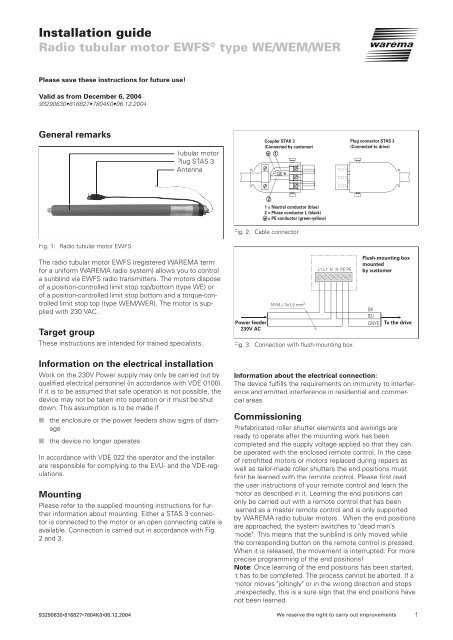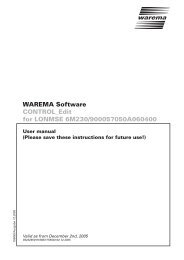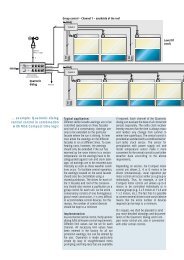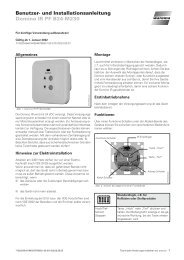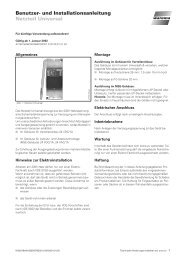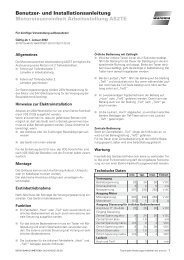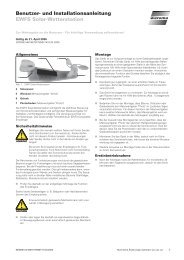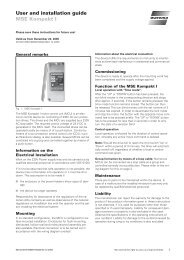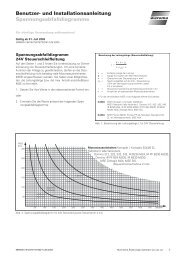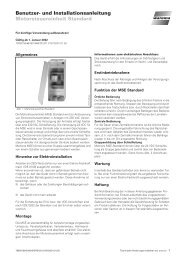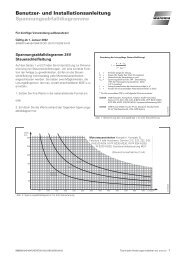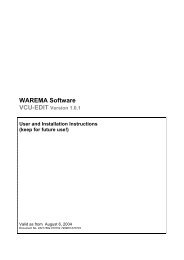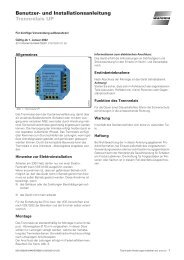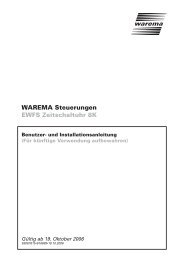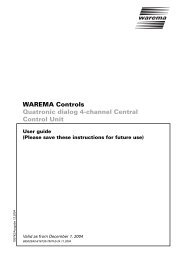Installation guide Radio tubular motor EWFS type WE ... - Warema
Installation guide Radio tubular motor EWFS type WE ... - Warema
Installation guide Radio tubular motor EWFS type WE ... - Warema
You also want an ePaper? Increase the reach of your titles
YUMPU automatically turns print PDFs into web optimized ePapers that Google loves.
Mode button "M"Learn button "L"Store button "S"Encoding switchBatteriesLS-AAA+2x IEC LR03 AAA+AAAFig. 4: Remote control (with battery compartment opened)Note:What about "waving"? The sunblind carries out a series ofdefined movements in order to confirm a completed programprocedure. We call this procedure "waving".Learning end positions (Type <strong>WE</strong>)■■■■■■■Press the mode button "M" (Fig. 4) of the remote control.The transmit LED begins to flash.Press the button "A" of the remote control for approx.2 seconds. This initiates learning of the end positions.Waving is not carried out!Move the sunblind to the lower end position. Keepthe button pressed during moving. The movement isinterrupted as soon as it is released. It is possible thata <strong>motor</strong> moves in the wrong direction, i.e. upwards,although you have pressed the "DOWN" button. Inthis case use the opposite button in order to move thesunblind downwards.When the lower end position has been reached, stopthe movement and press the button "A" of the remotecontrol for approx. 2 seconds. Waving is not carried out!Now move the sunblind to the upper end position. Keepthe button pressed during moving. The movement isinterrupted as soon as it is released.When the upper end position has been reached, stopthe movement and press the button "A" of the remotecontrol for approx. 2 seconds. The sunblind waves if theend position has been learned successfully.In Order to complete the learning process, press themode button "M" (Fig. 4) of the remote control, thetransmit LED extinguishes, the end positions and thedirection of rotation have been learned.Learning end positions (Type <strong>WE</strong>M/<strong>WE</strong>R)■■■Press the mode button "M" (Fig. 4) of the remote control.The transmit LED begins to flash.Press the button "A" of the remote control for approx.2 seconds. This initiates learning of the end positions.Waving is not carried out!Move the sunblind to the lower end position. Keep thebutton pressed during moving. The movement is interruptedas soon as it is released. It is possible that a drivemoves in the wrong direction, i.e. upwards, althoughyou have pressed the "DOWN" button. In this case usethe opposite button in order to move the sunblind downwards.-■When the lower end position has been reached, stop themovement and press the button "A" of the remote controlfor approx. 2 seconds. Waving is not carried out!■ Now move the sunblind upwards and stop it approx. 50mm before the upper end position is reached. Keep thebutton pressed during moving. The movement is interruptedas soon as it is released.■■Press the button "A" of the remote control for approx.2 seconds. The sunblind waves if the end position hasbeen learned successfully.In Order to complete the learning process, press themode button "M" (Fig. 4) of the remote control, thetransmit LED extinguishes, the end positions and thedirection of rotation have been learned.Safety instructionsNever press the buttons on your remote control if you cannotsee the sunblind!The range of radio control systems is limited by the statutoryregulations on radio systems and by structures. Whenplanning the system ensure that the radio reception is sufficient.This applies in particular if the transmitter and receiverand positioned in different rooms and the radio signal hasto penetrate walls and ceilings. The control system shouldnot be installed directly near metallic surfaces (steel girders,fire doors).■Therefore check the function of the receiver before finallycarrying out mounting.Powerful local transmission systems (for example, babyintercom or neighboring transmitters) whose transmissionfrequencies are identical to that of the control system, caninterfere with the reception.Group operation and special functionsManifold special functions are possible in WAREMA <strong>EWFS</strong>.Should you wish further information, your specialist dealerwill be pleased to send you the <strong>EWFS</strong> application brochure.MaintenanceThere are no parts to be maintained within the device.LiabilityThe manufacturer can reject the warranty for damage to theproduct if the product information given in these instructionsis not observed, if it is used for purposes other than thosespecified or if used improperly. Liability for consequent damageto persons or property is also excluded in this case. Observethe specifications in the operating instructions of yoursunblind. Liability for damage to the sunblind caused by operationduring icing or icy conditions is also excluded.2We reserve the right to carry out improvements93290630•816827•7804K0•06.12.2004
Usage to the intended purposeThe control system was developed for the control of sunprotection drives. The approval of the manufacturer has tobe obtained if the device is to be used to a purpose differentto that described here.DisposalThe device has to be disposed of or recycled in accordancewith the statutory regulations.HousingDegree of protectionSafety classConnectionPower supply/MotorIP44ITerminalsPower supply/Motor 0,5...2,5 mm 2Loop cable (230V) 0,5...2,5 mm 2Loop cable (CCU) 0,5...2,5 mm 2Cable connector or connectionwith flush-mounting boxUser informationFor use in:A, B, D, DK, E, F, FIN, GB, GR, I, IRL, L, NL, P, S, CH, IS, N.Transmitter and receiver for sunblind remote control.The device complies at intended use with the essential requirements,which are fixed in the following EC-Guidelinesand harmonized standards:- Directive on radio equipment and telecommunicationsterminal equipment and the mutual recognition of theirconformity 1999/5/EC(R&TTE)- Directive on electromagnetic compability 89/336 EEC- Low voltage directive 73/23/EWGLink to declaration of confirmity:http://www.warema.deTest standardsEN55014-1EN61000-4-1...-11EN50081-1: 1992EN50082-1: 1997EN301489-3: 2001OtherConformityTechnical data<strong>Radio</strong> <strong>tubular</strong> <strong>motor</strong><strong>EWFS</strong>Supply 230 VAC/50 Hzmin typ max unitOperating voltage 207 230 253 V ACHF-ReceiverReceive frequencyASK (OOK)433,92 MHzSensing range 30 mAmbient conditionsOperating temperature -25 +25 +75 °CStorage temperature 0 20 50 °CHumidity(non-condensing)5 95 %RH93290630•816827•7804K0•06.12.2004We reserve the right to carry out improvements3


